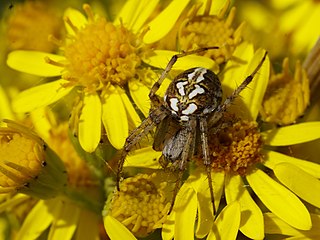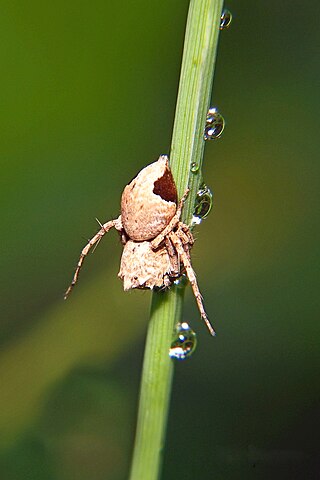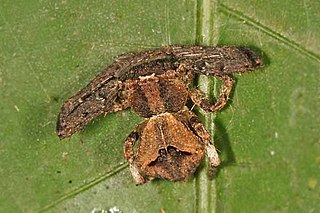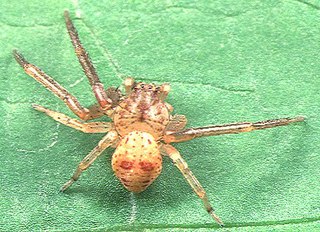
The Thomisidae are a family of spiders, including about 170 genera and over 2,100 species. The common name crab spider is often linked to species in this family, but is also applied loosely to many other families of spiders. Many members of this family are also known as flower spiders or flower crab spiders.

Ordgarius is a genus of orb-weaver spiders first described by Eugen von Keyserling in 1886. Adult females of the genus are bolas spiders, capturing their prey with one or more sticky drops at the end of a single line of silk rather than in a web. Males and juvenile females capture their prey directly with their legs.

Amyciaea is a genus of ant mimicking crab spiders that was first described by Eugène Louis Simon in 1885.

Neoscona, known as spotted orb-weavers and barn spiders, is a genus of orb-weaver spiders (Araneidae) first described by Eugène Simon in 1895 to separate these from other araneids in the now obsolete genus Epeira. The name Neoscona was derived from the Greek νέω, meaning "spin", and σχοῖνος, meaning "reed". They have a mostly pantropical distribution and one species, Neoscona adianta, has a palearctic distribution. As of April 2019 there are eight species that can be found in the United States and Canada.

Pistius is a genus of crab spiders with nine described species. Most occur in Asia, only P. truncatus has a palaearctic distribution.

Indoxysticus is a genus of Asian crab spiders that was first described by S. P. Benjamin & Z. Jaleel in 2010. As of September 2020 it contains three species, all found in Asia: I. lumbricus, I. minutus, and I. tangi. The genus differs from others in its family by the oval-shaped spermathecae with well-defined chambers in females and by the broad-based embolus in males.
Epidius is a genus of crab spiders that was first described by Tamerlan Thorell in 1877. It is a senior synonym of Pothaeus.

Hamataliwa is a genus of lynx spiders that was first described by Eugen von Keyserling in 1887.

Nilus is a genus of nursery web spiders that was first described by Octavius Pickard-Cambridge in 1876.

Ruborridion is a monotypic genus of Asian comb-footed spiders containing the single species, Ruborridion musivum. The species was first described under the name Theridion musivum in 1873. The genus was described by J. Wunderlich in 2011. They are found in India and in the mediterranean area

Angaeus is a genus of Asian crab spiders first described by Tamerlan Thorell in 1881. It is considered a senior synonym of Paraborboropactus.
Ansiea is a genus of crab spiders that was first described by Pekka T. Lehtinen in 2004. This genus was named in honour of South African arachnologist Ansie Dippenaar-Schoeman. As of June 2020 it contains two species found in Africa and Saudi Arabia: A. buettikeri and A. tuckeri.

Camaricus is a genus of crab spiders that was first described by Tamerlan Thorell in 1887.
Cebrenninus is a genus of crab spiders that was first described by S. P. Benjamin in 2016. It is a senior synonym of Ascurisoma.
Demogenes is a genus of crab spiders that was first described by Eugène Louis Simon in 1895.
Massuria is a genus of spiders in the family Thomisidae. It was first described in 1887 by Tamerlan Thorell. As of 2017, it contains 8 Asian species.

Pharta is a genus of crab spiders, family Thomisidae, first described by Tamerlan Thorell in 1891.

Bomis is a genus of very small crab spiders, first described by German arachnologist Ludwig Carl Christian Koch in 1874. Five species are currently described, with three species from India and two from Australia.
Serratacosa is a genus of wolf spiders. It was first described by L. Y. Wang, X. J. Peng and Z. S. Zhang in 2021, and it has only been found in China. As of January 2022 it contains only three species: S. himalayensis, S. medogensis, and S. multidontata.
Lycosa bistriata is a species of spiders of the genus Lycosa found in India and Bhutan. Males of this spider species exhibit different leg colouration. Of these one group of male spider resembles the female in coloration where as the other group the has black colour leg while the upper surface of tarsus is covered by thick white hair.












